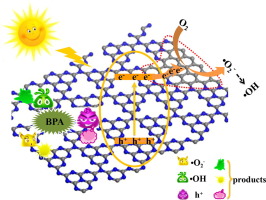当前位置:
X-MOL 学术
›
Appl. Surf. Sci.
›
论文详情
Our official English website, www.x-mol.net, welcomes your
feedback! (Note: you will need to create a separate account there.)
Surface amorphous carbon doping of carbon nitride for efficient acceleration of electron transfer to boost photocatalytic activities
Applied Surface Science ( IF 6.3 ) Pub Date : 2020-03-01 , DOI: 10.1016/j.apsusc.2019.145145 Feiyue Ge , Yuanguo Xu , Yihong Zhou , Dong Tian , Shuquan Huang , Meng Xie , Hui Xu , Huaming Li
Applied Surface Science ( IF 6.3 ) Pub Date : 2020-03-01 , DOI: 10.1016/j.apsusc.2019.145145 Feiyue Ge , Yuanguo Xu , Yihong Zhou , Dong Tian , Shuquan Huang , Meng Xie , Hui Xu , Huaming Li

|
Abstract Introducing a built-in electric field (BIEF) has been considered a promising strategy to separate photoinduced electron/hole pairs and to boost the photocatalytic performance of semiconductor photocatalysts. In this work, an amorphous carbon component was formed in-situ and modified on the surface of graphitic carbon nitride (g-C3N4) by copolymerization via a simple green method, in which the amorphous carbon could adjust the band structure and form a BIEF. A variety of measurements, such as X-ray photoelectron spectroscopy (XPS), Mott-Schottky plots and density functional theory calculations, revealed that the BIEF could adjust the intrinsic electronic state and promote photoinduced electron delocalization for the effective separation of carriers in the region, thereby boosting photoelectron transport and improving the reaction kinetics. As a result, the highly photocatalytic activity of CN-PhA30 was demonstrated by degrading bisphenol A (BPA), and the efficiency reached 100 % after 80 minutes of irradiation—a rate that was more than 13 times that of pure g-C3N4. It is worth mentioning that CN-PhA30 also exhibited higher photocatalytic activities for H2 generation and antibiotic degradation. The results showed that the enhanced photocatalytic performance could be attributed to the directional transfer of electrons due to the BIEF formed by amorphous carbon on the surface of g-C3N4.
中文翻译:

表面无定形碳掺杂氮化碳可有效加速电子转移以提高光催化活性
摘要 引入内建电场 (BIEF) 被认为是分离光致电子/空穴对和提高半导体光催化剂的光催化性能的一种有前景的策略。在这项工作中,通过简单的绿色方法共聚在石墨氮化碳(g-C3N4)表面原位形成和改性无定形碳组分,其中无定形碳可以调节能带结构并形成BIEF。X射线光电子能谱(XPS)、莫特-肖特基图和密度泛函理论计算等多种测量表明,BIEF可以调节本征电子态并促进光致电子离域,从而有效分离该区域的载流子,从而促进光电子传输并改善反应动力学。结果,CN-PhA30 的高光催化活性通过降解双酚 A (BPA) 得到证明,并且在照射 80 分钟后效率达到 100%,是纯 g-C3N4 的 13 倍以上。值得一提的是,CN-PhA30 对 H2 生成和抗生素降解也表现出更高的光催化活性。结果表明,增强的光催化性能可能归因于电子的定向转移,这是由于 g-C3N4 表面无定形碳形成的 BIEF。值得一提的是,CN-PhA30 对 H2 生成和抗生素降解也表现出更高的光催化活性。结果表明,增强的光催化性能可归因于电子的定向转移,这是由于 g-C3N4 表面无定形碳形成的 BIEF。值得一提的是,CN-PhA30 对 H2 生成和抗生素降解也表现出更高的光催化活性。结果表明,增强的光催化性能可归因于电子的定向转移,这是由于 g-C3N4 表面无定形碳形成的 BIEF。
更新日期:2020-03-01
中文翻译:

表面无定形碳掺杂氮化碳可有效加速电子转移以提高光催化活性
摘要 引入内建电场 (BIEF) 被认为是分离光致电子/空穴对和提高半导体光催化剂的光催化性能的一种有前景的策略。在这项工作中,通过简单的绿色方法共聚在石墨氮化碳(g-C3N4)表面原位形成和改性无定形碳组分,其中无定形碳可以调节能带结构并形成BIEF。X射线光电子能谱(XPS)、莫特-肖特基图和密度泛函理论计算等多种测量表明,BIEF可以调节本征电子态并促进光致电子离域,从而有效分离该区域的载流子,从而促进光电子传输并改善反应动力学。结果,CN-PhA30 的高光催化活性通过降解双酚 A (BPA) 得到证明,并且在照射 80 分钟后效率达到 100%,是纯 g-C3N4 的 13 倍以上。值得一提的是,CN-PhA30 对 H2 生成和抗生素降解也表现出更高的光催化活性。结果表明,增强的光催化性能可能归因于电子的定向转移,这是由于 g-C3N4 表面无定形碳形成的 BIEF。值得一提的是,CN-PhA30 对 H2 生成和抗生素降解也表现出更高的光催化活性。结果表明,增强的光催化性能可归因于电子的定向转移,这是由于 g-C3N4 表面无定形碳形成的 BIEF。值得一提的是,CN-PhA30 对 H2 生成和抗生素降解也表现出更高的光催化活性。结果表明,增强的光催化性能可归因于电子的定向转移,这是由于 g-C3N4 表面无定形碳形成的 BIEF。















































 京公网安备 11010802027423号
京公网安备 11010802027423号